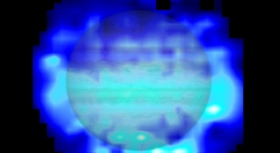Jovian Water Source

Water can be found most anywhere in the solar system planetary bodies. The question is amount and source. Astronomers have finally found direct proof that almost all water present in Jupiter's stratosphere was delivered by comet Shoemaker-Levy 9, which famously struck the planet in 1994. The findings, based on new data from the Herschel space observatory, reveal more water in Jupiter's southern hemisphere, where the impacts occurred, than in the north. Herschel is a European Space Agency mission with important NASA participation.
Comet Shoemaker—Levy 9 (formally designated) was a comet that broke apart and collided with Jupiter in July 1994, providing the first direct observation of an extraterrestrial collision of Solar System objects. This generated a large amount of coverage in the popular media, and the comet was closely observed by astronomers worldwide. The collision provided new information about Jupiter and highlighted its role in reducing space debris in the inner Solar System.
Comet nuclei are known to range from about 100 meters to more than 40 kilometres across. They are composed of rock, dust, water ice, and frozen gases such as carbon monoxide, carbon dioxide, methane and ammonia.
The origin of water in the upper atmospheres of the solar system's giant planets has been debated for almost two decades. Astronomers were quite surprised at the discovery of water in the stratospheres of Jupiter, Saturn, Uranus and Neptune, which dates to observations performed with ESA's Infrared Space Observatory in 1997.
While the source of water in the lower layers of their atmospheres can be explained as internal, the presence of this molecule in their upper atmospheric layers is puzzling due to the scarcity of oxygen there. Its supply must have an external origin. Since then, astronomers have investigated several possible candidates that may have delivered water to these planets, from icy rings and satellites to interplanetary dust particles and cometary impacts.
Data from Herschel's Photodetecting Array Camera and Spectrometer (PACS), with the help of NASA's Infrared Telescope Facility, helped solve the mystery at Jupiter by showing an asymmetry in the distribution of water in its stratosphere, caused by the comet impact. Additional proof for a cometary source for the water came from Hershel's heterodyne instrument for the far infrared (HIFI), which probed the vertical profile of water in the stratosphere.
"The asymmetry between the two hemispheres suggests that water was delivered during a single event and rules out icy rings or moons as candidate sources," says Thibault Cavalié from the Laboratoire d'Astrophysique de Bordeaux, France, who led the study. "Local sources would provide a steady supply of water, which over time would lead to a hemispherically symmetric distribution in the stratosphere. Depending on whether the chemical species are transported in neutral or ionized form, local sources of water would result in higher concentrations either at the poles or along the equator, but not in a north-south asymmetry."
For further information see Jovian Water Source.
White and cyan indicate highest concentration of water, and blue indicates lesser amounts in this image. Image credit: Water map: ESA/Herschel/T. Cavalié et al.; Jupiter image: NASA/ESA/Reta Beebe (New Mexico State University).
©2013. Copyright Environmental News Network To subscribe or visit go to: http://www.enn.com